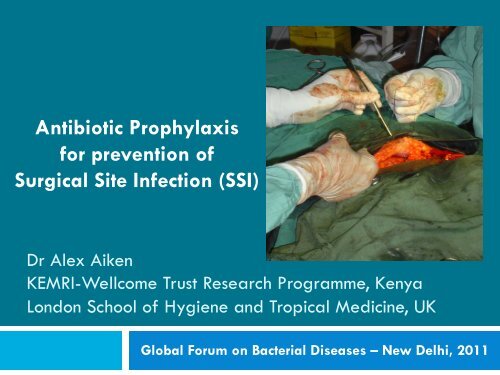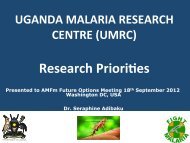Antibiotic Prophylaxis for prevention of Surgical Site Infection (SSI)
Antibiotic Prophylaxis for prevention of Surgical Site Infection (SSI)
Antibiotic Prophylaxis for prevention of Surgical Site Infection (SSI)
You also want an ePaper? Increase the reach of your titles
YUMPU automatically turns print PDFs into web optimized ePapers that Google loves.
<strong>Antibiotic</strong> <strong>Prophylaxis</strong><br />
<strong>for</strong> <strong>prevention</strong> <strong>of</strong><br />
<strong>Surgical</strong> <strong>Site</strong> <strong>Infection</strong> (<strong>SSI</strong>)<br />
Dr Alex Aiken<br />
KEMRI-Wellcome Trust Research Programme, Kenya<br />
London School <strong>of</strong> Hygiene and Tropical Medicine, UK<br />
Global Forum on Bacterial Diseases – New Delhi, 2011
What is a <strong>Surgical</strong> <strong>Site</strong> <strong>Infection</strong> (<strong>SSI</strong>)<br />
CDC/NHSN definition <strong>of</strong> <strong>SSI</strong>: “<strong>Infection</strong> occurring at the operation<br />
site within 30 days <strong>of</strong> the procedure.”<br />
ref: Horan TC, Am J Inf Cont 2008<br />
Less severe, but harder to<br />
reliably diagnose<br />
More severe, but<br />
less common
<strong>SSI</strong> – how much <strong>of</strong> a problem<br />
3<br />
Results: “<strong>Surgical</strong>-site infection was the leading infection in hospitals ... ,<br />
strikingly higher than proportions recorded in developed countries.”<br />
<strong>Antibiotic</strong> prophylaxis <strong>for</strong> <strong>prevention</strong> <strong>of</strong> <strong>SSI</strong>
The “antibiotic problem”<br />
4<br />
The problem: mismatch between antibiotic usage and need<br />
<strong>Antibiotic</strong> Usage<br />
Actual need<br />
<strong>for</strong> antibiotics<br />
The solution: 1) reduce antibiotic usage<br />
<strong>Antibiotic</strong> prophylaxis <strong>for</strong> <strong>prevention</strong> <strong>of</strong> <strong>SSI</strong><br />
2) align reduced usage with actual need
Need <strong>for</strong> antibiotics<br />
5<br />
Actual need<br />
<strong>for</strong> antibiotics<br />
Hospitals Community Veterinary<br />
<strong>Antibiotic</strong> prophylaxis <strong>for</strong> <strong>prevention</strong> <strong>of</strong> <strong>SSI</strong>
<strong>Surgical</strong> antibiotic prophylaxis (AP)<br />
6<br />
<strong>Surgical</strong> <strong>Antibiotic</strong> <strong>Prophylaxis</strong> (AP)<br />
to prevent <strong>Surgical</strong> <strong>Site</strong> <strong>Infection</strong>s (<strong>SSI</strong>)<br />
Actual need<br />
<strong>for</strong> antibiotics<br />
Hospitals<br />
Huge evidence base to support use <strong>of</strong> AP<br />
eg. Smaill et al, Cochrane Library, 2010<br />
Bowater et al, Annals <strong>of</strong> Surg, 2009<br />
AP should be<br />
¨ PRE-operative (0-30 mins be<strong>for</strong>e skin incision)<br />
¨ Single intra-venous dose<br />
¨ Appropriate to local pathogens<br />
<strong>Antibiotic</strong> prophylaxis <strong>for</strong> <strong>prevention</strong> <strong>of</strong> <strong>SSI</strong>
7<br />
Thika Hospital, Central Province, Kenya
Use <strong>of</strong> AP in Thika Hospital<br />
8<br />
From June 2010 to Feb 2011<br />
98% <strong>of</strong> surgical patients received:<br />
¨ Post-operative prescription <strong>of</strong> 2 or 3 IV agents <strong>for</strong> 5 to 7 days<br />
¤ Normally Penicillin (79%) + Metronidazole (85%)<br />
¤ Also Gentamycin (45%), Ceftriaxone (11%) used.<br />
¤ Average <strong>of</strong> 32 doses <strong>of</strong> iv antibiotics prescribed<br />
¨ First dose given several hours post-op<br />
¨ Normally switched to oral ampicillin+flucloxacillin after 72 hrs.<br />
à Similar regime (probably) used in most Government Hospitals<br />
in Kenya, though private hospitals better.<br />
<strong>Antibiotic</strong> prophylaxis <strong>for</strong> <strong>prevention</strong> <strong>of</strong> <strong>SSI</strong>
Intervention: Hospital AP Policy<br />
9<br />
Policy Development + Implementation<br />
¨ Series <strong>of</strong> seminars (Nov 2010 – Jan 2011) to review evidence and<br />
National Guidelines to produce a locally appropriate AP Policy<br />
¨ “Buy-in” from all senior surgeons and Hospital Director<br />
¨ Policy implemented from 7 th Feb 2011<br />
¨ Ongoing feedback provided about compliance with policy<br />
Policy Content:<br />
1. All surgical patients to receive PRE-operative AP<br />
2. Drugs used<br />
Ampicillin 2g + Metronidazole 500mg <strong>for</strong> most surgery<br />
Ceftriaxone 2g<br />
<strong>Antibiotic</strong> prophylaxis <strong>for</strong> <strong>prevention</strong> <strong>of</strong> <strong>SSI</strong><br />
<strong>for</strong> Orthopaedic surgery<br />
3. No routine post-operative antibiotics should be given<br />
(<strong>for</strong> Clean and Clean-Contaminated Surgery)
Why Ampicillin <strong>for</strong> AP <br />
10<br />
Advantages<br />
¨ Cheap drug (approx US$0.50 <strong>for</strong> dose)<br />
¨ Non-toxic, generally safe<br />
¨ t½ = 1 hour<br />
¨ Reasonable coverage<br />
¨ Good tissue penetration<br />
¨ Not otherwise used in TL5H<br />
¨ On Kenya Essential Medicines List<br />
Concerns<br />
Possible allergic reactions – but rare<br />
Ampicillin resistance is common in clinical<br />
isolates in Kenya<br />
But<br />
¨<br />
<strong>Prophylaxis</strong> is to reduce inoculum rather<br />
than treat an infection<br />
<strong>Antibiotic</strong> prophylaxis <strong>for</strong> <strong>prevention</strong> <strong>of</strong> <strong>SSI</strong>
ANTIBIOTIC TREATMENT<br />
<strong>Infection</strong> with single strain <strong>of</strong> bacteria<br />
Sensitive to antibiotic<br />
ALL bacteria killed<br />
Sensitive<br />
Resistant<br />
Resistant to antibiotic<br />
No effect <strong>of</strong> treatment
ANTIBIOTIC PROPHYLAXIS<br />
Diverse bacterial contamination<br />
Reduction in bacterial population<br />
<strong>Antibiotic</strong><br />
<strong>Prophylaxis</strong><br />
= bacteria resistant to antibiotic<br />
Some bacteria killed even if some<br />
antibiotic resistance is present
Results <strong>of</strong> intervention<br />
13<br />
Monitoring the effects <strong>of</strong> AP Policy introduction on<br />
1. Use <strong>of</strong> antibiotics in surgical patients<br />
2. Rate <strong>of</strong> <strong>SSI</strong><br />
3. Pathogens and antibiotic resistance with <strong>SSI</strong><br />
Data collection is ongoing...<br />
<strong>Antibiotic</strong> prophylaxis <strong>for</strong> <strong>prevention</strong> <strong>of</strong> <strong>SSI</strong>
% given PRE-op AP % given POST-op antibiotics<br />
1. Use <strong>of</strong> antibiotics <strong>for</strong> AP in Thika Hospital<br />
14<br />
100%<br />
AP used in Clean and Clean-Contaminated Operations<br />
80%<br />
60%<br />
40%<br />
AP Policy<br />
introduced<br />
Feb 2011<br />
20%<br />
0%
1. Use <strong>of</strong> antibiotics <strong>for</strong> AP in Thika Hospital<br />
15<br />
50%<br />
Timing <strong>of</strong> pre-op AP, relative to skin incision<br />
40%<br />
30%<br />
20%<br />
10%<br />
0%<br />
Within 10<br />
mins<br />
10-20 mins<br />
be<strong>for</strong>e<br />
20-30 mins<br />
be<strong>for</strong>e<br />
30-60 mins<br />
be<strong>for</strong>e<br />
1.7%<br />
outside <strong>of</strong><br />
60 min<br />
"window"<br />
Data not<br />
available
2. Rate <strong>of</strong> <strong>SSI</strong><br />
16<br />
Type <strong>of</strong> <strong>Surgical</strong> <strong>Site</strong> Infec3on <br />
(Clinical Diagnosis) <br />
Post-‐opera3ve abx <br />
ONLY <br />
(“old” regime) <br />
Pre-‐opera3ve AP <br />
+/-‐ post-‐op abx <br />
(“new” regime)* <br />
Any <strong>SSI</strong> (%) 77 (7.1%) 71 (5.4%) <br />
<strong>SSI</strong> reported by phone only (%) 32 (2.9%) 30 (2.3%) <br />
Superficial <strong>SSI</strong> (%) 32 (2.9%) 30 (2.3%) <br />
Deep <strong>SSI</strong> (%) 10 (0.9%) 7 (0.5%) <br />
Organ-‐Space <strong>SSI</strong> (%) 3 (0.3%) 4 (0.3%) <br />
All Opera3ons (%)† 1,094 (100%) 1,304 (100%)* <br />
† = <strong>for</strong> CLEAN and CLEAN-CONTAMINATED surgery only<br />
* = 36 operations since 7 th Feb which were not documented to get AP excluded<br />
<strong>Antibiotic</strong> prophylaxis <strong>for</strong> <strong>prevention</strong> <strong>of</strong> <strong>SSI</strong>
3. <strong>Antibiotic</strong> resistance in <strong>SSI</strong> cases<br />
17<br />
Pseudomonas<br />
spp<br />
1%<br />
Pseudomonas<br />
aeruginosa<br />
3%<br />
Klebsiella<br />
pneumoniae<br />
1%<br />
Corynebacterium spp<br />
1%<br />
Isolates “be<strong>for</strong>e” Policy change<br />
(n=120)<br />
Proteus<br />
mirabillis<br />
3%<br />
Enterococcus spp<br />
2%<br />
Acinetobacter<br />
baumani<br />
2%<br />
CoNS<br />
5%<br />
E. coli<br />
7%<br />
Staphylococcus<br />
spp<br />
4%<br />
S. aureus<br />
5%<br />
no growth<br />
24%<br />
no sample<br />
obtained<br />
42%<br />
Pseudom.<br />
aeruginosa<br />
4%<br />
Proteus<br />
mirabillis<br />
4%<br />
Klebsiella<br />
pneumoniae<br />
4%<br />
Corynebacterium<br />
spp<br />
1%<br />
Enterococcus<br />
spp<br />
3%<br />
Isolates “after” Policy change<br />
(n=117)<br />
CoNS<br />
3%<br />
E.coli<br />
8%<br />
Acinetobacter<br />
baumani<br />
3%<br />
S.aureus<br />
10%<br />
no<br />
growth<br />
18%<br />
no<br />
sample<br />
obtained<br />
39%
3. <strong>Antibiotic</strong> resistance in <strong>SSI</strong> isolates<br />
18<br />
Drug Species tested against BEFORE<br />
AP Policy<br />
% Sensitive<br />
Ampicillin<br />
E.coli, Proteus spp.,<br />
Enterococci, K.pneumo<br />
AFTER<br />
AP Policy<br />
% Sensitive<br />
23% (3/13) 19% (4/21)<br />
Gentamicin<br />
Cefotaxime<br />
E.coli, Proteus spp.,<br />
Staph spp. , E.cloacae,<br />
Acinetobacter<br />
E.coli, Proteus spp.<br />
E.cloacae, K. Pneumo<br />
52% (11/21) 66% (16/24)<br />
45% (5/11) 53% (9/17)<br />
Cipr<strong>of</strong>loxacin E.coli, Proteus spp.,<br />
Pseudomonas spp.,<br />
Staph spp. E.cloacae<br />
78% (18/23) 73% (19/26)
Summary <strong>of</strong> results<br />
19<br />
1. Policy introduction has “rationalised” antibiotic use<br />
and reduced overall antibiotic consumption<br />
but<br />
Ø<br />
Ø<br />
Development <strong>of</strong> AP Policy took many months<br />
Implementation <strong>of</strong> AP Policy was “challenging”<br />
2. Possibly small reduction in <strong>SSI</strong> rate<br />
3. No major impact on pathogens or drug resistance<br />
<strong>Antibiotic</strong> prophylaxis <strong>for</strong> <strong>prevention</strong> <strong>of</strong> <strong>SSI</strong>
Could this approach be applied elsewhere<br />
20<br />
Kazan Federal<br />
University, Russia<br />
<strong>Antibiotic</strong> prophylaxis <strong>for</strong> <strong>prevention</strong> <strong>of</strong> <strong>SSI</strong>
21<br />
IMPROVING ANTIBIOTIC PRESCRIBING:<br />
INTRODUCTION OF PERIOPERATIVE ANTIBACTERIAL <br />
PROPHYLAXIS<br />
Anna A. Korableva 1,2 , Ekaterina V. Yudina 1,2 , Razilay V. Davletshina 1 , Rustem F. Gaifullin 1 , Lilia E. Ziganshina 2 <br />
1 Republican Clinical Hospital N1, Kazan, 2 Kazan Federal University <br />
Fig. 1. Change <strong>of</strong> use <strong>of</strong> systemic antibiotics (DDD/100 bed-days) at the<br />
department <strong>of</strong> vascular surgery following interventions , 2007-2009 <br />
DDD/100 bed-days <br />
1 4 2,3 4 <br />
months <br />
(2) <strong>of</strong>ficial order on the implementa3on <strong>of</strong> PABP was issued (Oct 2008); <br />
(3) changes in the list <strong>of</strong> drug prescrip3ons <strong>for</strong> registra3on <strong>of</strong> the first pre-‐opera3ve an3bio3c dose was introduced (Oct 2008);
Acknowledgements<br />
22<br />
Supervisors<br />
Anthony Scott<br />
Andy Hall<br />
Hajo Grundmann<br />
Sam Kariuki<br />
Neal Alexander<br />
Funding+Support<br />
Wellcome-Trust (UK)<br />
KEMRI-WTRP (Kenya)<br />
LSHTM (UK)<br />
CDDEP<br />
Staff at Thika Hospital<br />
<strong>Antibiotic</strong> prophylaxis <strong>for</strong> <strong>prevention</strong> <strong>of</strong> <strong>SSI</strong>
















